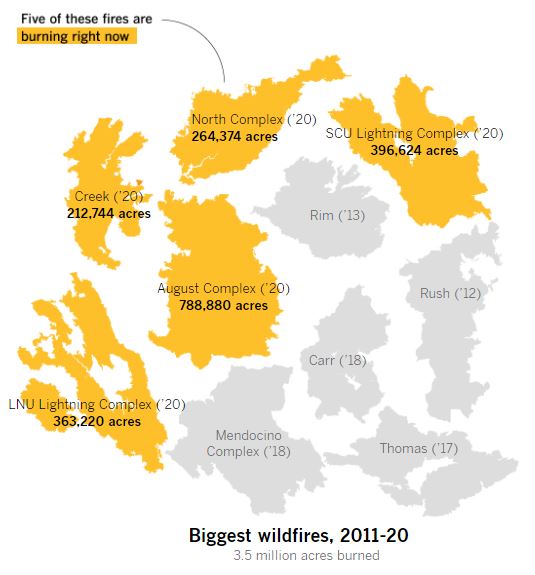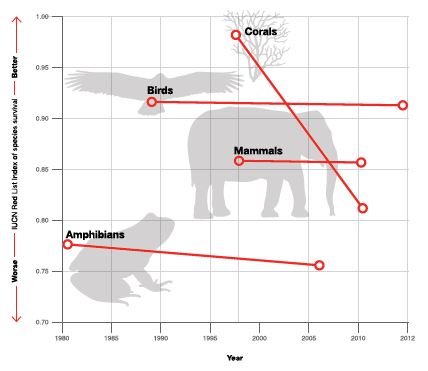
This September when Californian forests were swallowed by blazing fires for days and nights, week after week, the country’s top leader blamed the uncleared dead trees and leaves for flames that “explode like a matchstick” in the forest. When it comes to climate crisis, there is no alternative fact: the year’s wildfires are the worst on record. Of the ten largest wildfires in the last decade in California, five of them took place in 2020. The biggest of the five is the August Complex fire, the largest in state history. Taking the lead of the 45th President of the United States who said blatantly, “It’ll start getting cooler. You just watch,” the cooling of planet Earth’s temperature is now under your watch.

So, what is the temperature of Earth’s relentless fever in 2020? You may remember this year began with the Black Summer in Down Under. The unusually intense bushfires in Australia have destroyed lives of both humans and non-humans. Yes, I have to pigeonhole, if you will, human and non-human for the cause and damage related to global warming. In the Anthropocene, the age of man, humans have caused significant impact on Earth’s geology and ecosystems. Only humans can make amends, or worse, live with the human-induced consequences. If you know Australia is among the top ten most coal-dependent countries in the world, perhaps it is not hard to understand why Australian bushfires happened in such madness. July 2020 was one of Earth’s hottest months ever recorded. It tied with July 2016 as the second-hottest month ever recorded for the planet Earth, according to the National Oceanic and Atmospheric Administration. On August 17, Death Valley in Southern California reached 130 degrees Fahrenheit. Warm and moist air in the atmosphere keeps fueling tropical cyclones that grow stronger, bigger, and faster. 2020 has been one of the most active North Atlantic hurricane seasons on record, so active that meteorologists have run out of human names for hurricanes. Only twice has the National Hurricane Center ever run out of human names for tropical storms and had to turn to its backup: the Greek alphabet. Once was in 2005, when 27 names were given, the last one being Zeta, six letters in. Let us watch how many Greek alphabets will make meteorological history in 2020.
Heatwave is a silent killer. Humans report sweltering discomfort and even death toll caused by heatwaves when the European summer is becoming increasingly hot. But humans have fewer reports on non-humans that are living under even greater stress from loss of habitats and global warming. In the aftermath of Australian bushfires, more than 100 threatened species were reported heading toward extinction. In addition to the koala which is much loved by people around the world, scientists are calling for rescue efforts of endangered species including 272 species of plants, 16 mammals, 14 frogs, 9 birds, 7 reptiles, 4 insects, 4 fish and 1 spider. I cannot fathom how many non-humans are lost in Californian wildfires, given the fact that the highest-ranking American climate denier has already downplayed the covid infections and its far-reaching consequences. The mishandling of the loss of human lives from covid—an upward trend of 200,000 lives—speaks for itself how little politicians care about the life and death of their citizens. The loss of non-humans in Californian wildfires may never come to light or be valued by politicians on a par with human life.
The fact that humans love koalas makes the marsupial receiving the most limelight from media. Endangered species like tammar wallabies or pygmy possums are lesser known to the public outside Australia. About 5,000 koalas in New South Wales may have died in the bushfires, recording as much as two-thirds of their population dropping in less than 20 years. Wildlife conservation is never treated as a priority by mankind. That is why humanity has failed miserably to curb the loss of biodiversity. Scientists warn that one million of the nearly 9 million estimated plants and animals could be pushed over the brink in the next few years by habitat destruction, pollution, overexploitation, the spread of invasive species across the globe, and climate change. The IUCN Red List shows more than 60 percent of the world’s coral reefs are threatened.
Conservation of corals is increasing critical. So is pinna nobilis, or the Mediterranean Fan Mussel. The Mediterranean’s largest clam is now officially recognized and listed as “Critically Endangered” by the IUCN Red List of Threatened Species. The fan mussels reach up to four feet of shell length and are efficient filter feeders that help remove excess nitrogen from waters by incorporating it into their shells and tissue as they grow. Now the ocean is losing these large filters as a result of the mortality outbreak caused by a pathogen that has spread quickly along the Mediterranean Sea. Check out here to see the clam image.

If humans are vulnerable to zoonotic diseases that are caused by germs spreading between animals and people, wildlife is even more vulnerable to the increasing pathogens and diseases that could cause a mortality outbreak. COVID-19 suggests that SARS-CoV-2 has a zoonotic source, thus the novel coronavirus is infectious to humans. Rising global temperatures have fostered new diseases and helped others reappear. While humans are battling covid this year, pygmy hogs—the world’s smallest and rarest wild pig—are under a virus lockdown as well. The first outbreak of African swine fever hit India, killing over 16,000 domestic pigs in the region. Pygmy hogs that were thought to be extinct in the 1960s now survive with humans’ helping hand in a conservation breeding program. But in 2020, they are facing a new challenge of survival. Thanks to a prompt lockdown of the breeding center, the hogs survive. Conservationists said African swine fever could have “wiped out the whole population” of the rare wild pig.
Conservation stories like this abound. In the end, the story is about the human decision to protect non-humans and promote biodiversity on the planet. Not every species is that lucky. Six months later after Australian bushfires, even the koala has fallen into a political storm over its conservation. The row revolves around a new policy that restricts construction in the habitats of koala in New South Wales, Australia. If all lives matter—human and non-human, saving the endangered species is under your watch, too.
